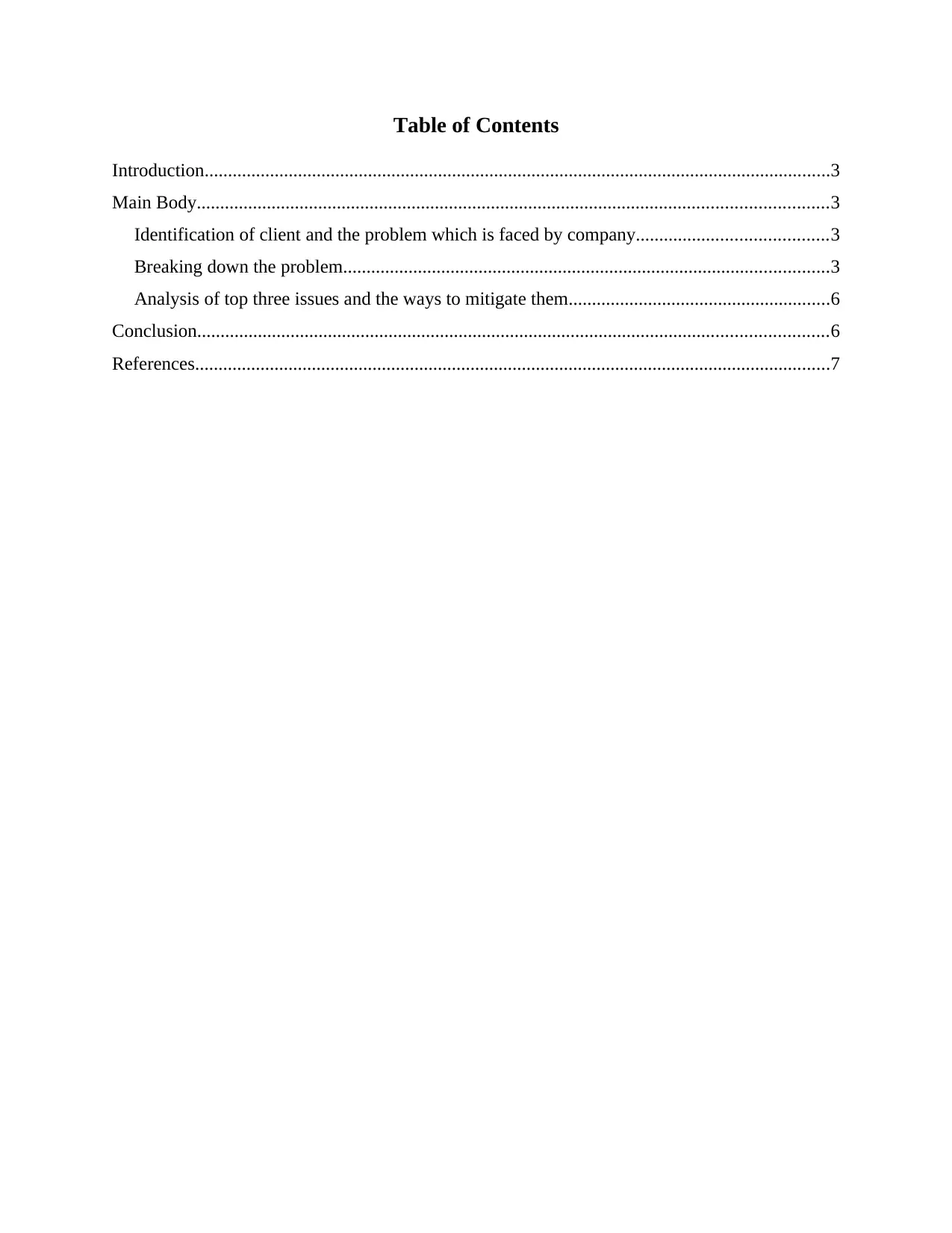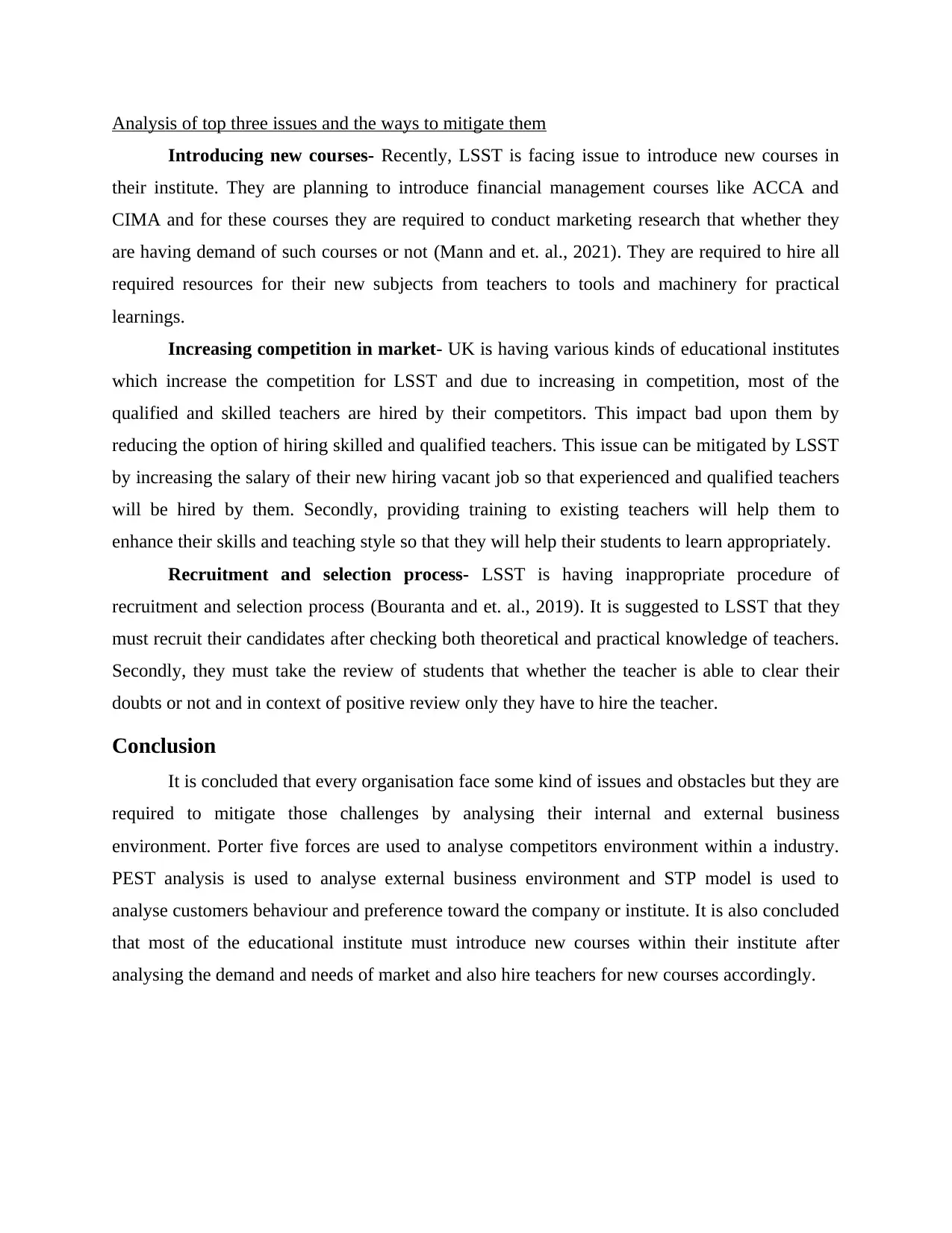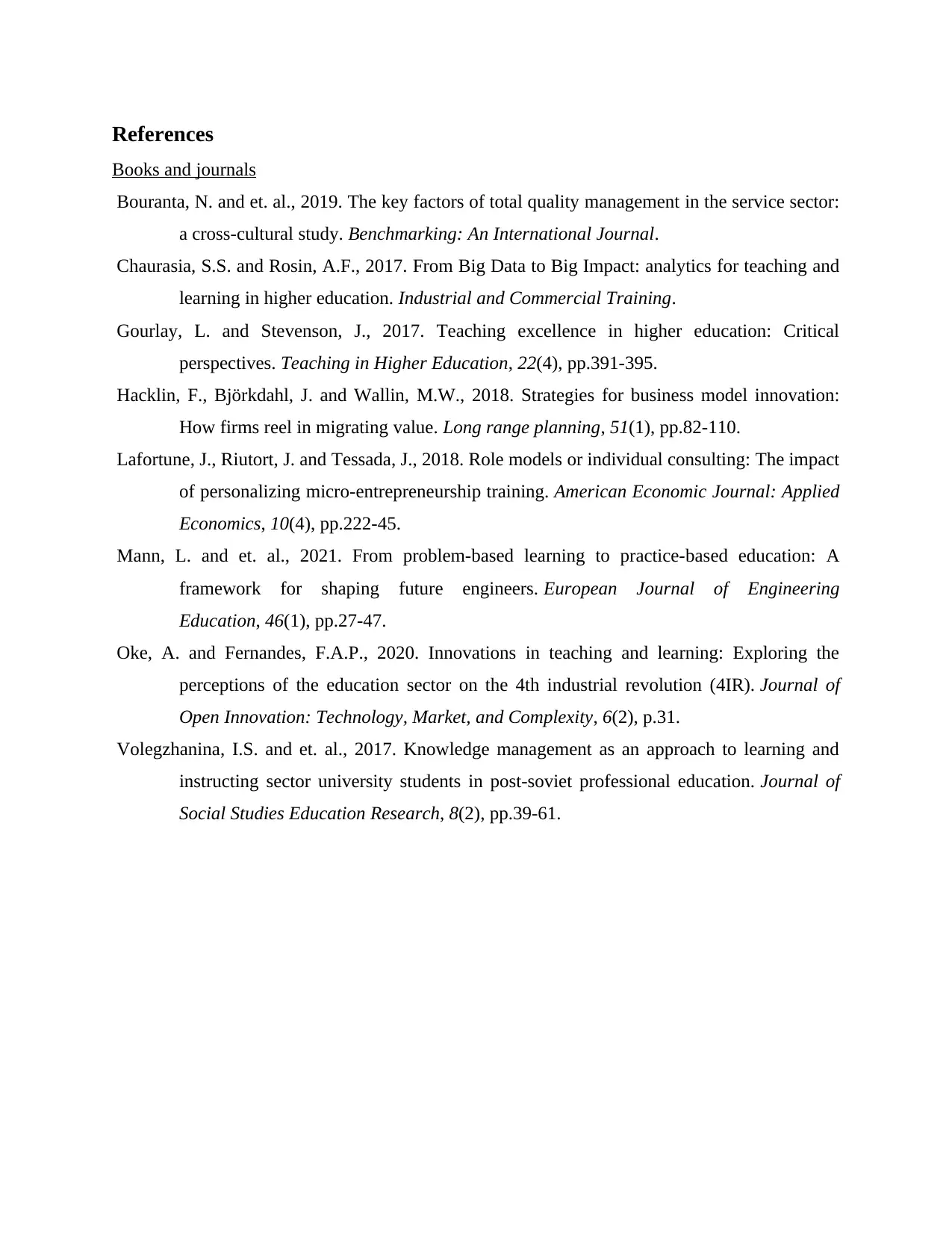LSST Consulting: Problem Breakdown, Analysis, & Recommendations
VerifiedAdded on 2023/06/15
|7
|2040
|112
Report
AI Summary
This consulting report identifies the challenges faced by the London School of Science and Technology (LSST), focusing on introducing new courses like ACCA and CIMA, increasing competition, and improving the recruitment process. It employs Porter's Five Forces, PEST analysis, and the STP model to break down the problems. The report analyzes the competitive landscape, external environmental factors, and customer segmentation to provide targeted recommendations. Key mitigation strategies include conducting thorough market research, enhancing recruitment processes, and differentiating through unique learning styles. The report emphasizes the importance of adapting to market demands and leveraging technological advancements to maintain a competitive edge. Desklib provides access to similar solved assignments and resources for students.

Business Consulting
Paraphrase This Document
Need a fresh take? Get an instant paraphrase of this document with our AI Paraphraser

Table of Contents
Introduction......................................................................................................................................3
Main Body.......................................................................................................................................3
Identification of client and the problem which is faced by company.........................................3
Breaking down the problem........................................................................................................3
Analysis of top three issues and the ways to mitigate them........................................................6
Conclusion.......................................................................................................................................6
References........................................................................................................................................7
Introduction......................................................................................................................................3
Main Body.......................................................................................................................................3
Identification of client and the problem which is faced by company.........................................3
Breaking down the problem........................................................................................................3
Analysis of top three issues and the ways to mitigate them........................................................6
Conclusion.......................................................................................................................................6
References........................................................................................................................................7

Introduction
It is essential for a organisation to analyse their internal and external business
environment and analyse what all factors are impacting them positively and what all factors are
impacting them negatively so that they will take actions to mitigate known risks (Oke and
Fernandes, 2020). In context of education sector, it is essential for them to analyse their
environment and those factors which will help them to gain large number of admission of
students. London School of Science and Technology (LSST) was founded in 2003 by Mr. Shed
Zaidi. It has its four branches in London and one branch in Birmingham. The following report
covers identification of client and the problem which is faced by company. It also covers
breaking down the problem by using competitors analysis, PEST analysis and customer (student)
analysis. This report will ends with analysing three problems faced by LSST and how they can
mitigate them.
Main Body
Identification of client and the problem which is faced by company
An HR Officer is the main client of the LSST school which will help them to analyse
their main issues and how such issues are impacting bad upon their institutes. HR officer is opted
because they will help the LSST to analyse how the management of staff impacts the
organisational growth and what all external requirement they need to achieve their aims and
objectives. The main problem of LSST school is to introduce new courses of ACCA and CIMA
for the growth of their institute and attract more students. Hence, it is suggested them that they
can conduct a marketing research and analyse which all courses are having more demand in
market and try to introduce those courses only (Lafortune, Riutort and Tessada, 2018). Secondly,
they are science and technological institutes which means in case they introduce financial
management courses like ACCA and CIMA then they are also required to hire qualified and
skilled teachers for their new subjects. Hence, identifying new recruitment and selection process
for new staff members is also their one of the biggest issue.
Breaking down the problem
To break down various organisational issue of LSST, they use some of the marketing model
which are mentioned below-
It is essential for a organisation to analyse their internal and external business
environment and analyse what all factors are impacting them positively and what all factors are
impacting them negatively so that they will take actions to mitigate known risks (Oke and
Fernandes, 2020). In context of education sector, it is essential for them to analyse their
environment and those factors which will help them to gain large number of admission of
students. London School of Science and Technology (LSST) was founded in 2003 by Mr. Shed
Zaidi. It has its four branches in London and one branch in Birmingham. The following report
covers identification of client and the problem which is faced by company. It also covers
breaking down the problem by using competitors analysis, PEST analysis and customer (student)
analysis. This report will ends with analysing three problems faced by LSST and how they can
mitigate them.
Main Body
Identification of client and the problem which is faced by company
An HR Officer is the main client of the LSST school which will help them to analyse
their main issues and how such issues are impacting bad upon their institutes. HR officer is opted
because they will help the LSST to analyse how the management of staff impacts the
organisational growth and what all external requirement they need to achieve their aims and
objectives. The main problem of LSST school is to introduce new courses of ACCA and CIMA
for the growth of their institute and attract more students. Hence, it is suggested them that they
can conduct a marketing research and analyse which all courses are having more demand in
market and try to introduce those courses only (Lafortune, Riutort and Tessada, 2018). Secondly,
they are science and technological institutes which means in case they introduce financial
management courses like ACCA and CIMA then they are also required to hire qualified and
skilled teachers for their new subjects. Hence, identifying new recruitment and selection process
for new staff members is also their one of the biggest issue.
Breaking down the problem
To break down various organisational issue of LSST, they use some of the marketing model
which are mentioned below-
⊘ This is a preview!⊘
Do you want full access?
Subscribe today to unlock all pages.

Trusted by 1+ million students worldwide

Porter's five forces- This model is used to analyse competitors and their impact upon a
company. Porter five forces of LSST institute is mentioned below-
Threat of new entrants- LSST is one of the most popular science and technological
institute in London which is having good technologies for better learnings of their students.
Hence, LSST institute has low impact from this threat due to their high brand image in market.
Bargaining power of buyers- In context of LSST, there are over 4000 students studying
in this institute. Hence, they are able to attract a good amount of students for the admissions.
They can reconstruct the fee structure well and reduce fee as compared to their competitors
(Gourlay and Stevenson, 2017). They can also adopt high technological tools in their physics and
chemistry labs for developing the condition of their infrastructure.
Bargaining power of suppliers- In context of LSST, their suppliers are those companies
which provide them furniture for their classrooms, technological tools and machines for their
labs and many others. Hence, it is suggested that they must have more than one supplier so that
in case any supplier refuse to provide them their required objects then they will instantly switch
to another supplier. It is also essential for them to focus on the prices of their furniture,
technological tools and machines and deal with those suppliers only which provide them quality
objects in low prices as compared to other suppliers in market.
Threat of substitute products- Substitute products are those products which are used in
place of each other (Chaurasia and Rosin, 2017). In context of UK, there are various institutes
which can copy the logo and teaching style of LSST to attract more students. Hence, it is
suggested that they must use trademark and copyright features so that no one can copy their logo
in the market. On the other hand, it is also suggested that they must change their learning styles
for students on regular basis so that their competitors did not copy their learning styles.
Rivalry among existing competitors- In context of LSST, they are having various
competitors like King's college London and many others. LSST can gain competitive advantage
by analysing the strategies of their competitors and make effective defending strategies to defeat
their competitors. LSST can reduce the fee of their students and must hire qualifies and
experienced teachers for better learning of students.
PEST analysis- This is the model which is used to analyse external business environment. PEST
analysis of LSST is mentioned below-
company. Porter five forces of LSST institute is mentioned below-
Threat of new entrants- LSST is one of the most popular science and technological
institute in London which is having good technologies for better learnings of their students.
Hence, LSST institute has low impact from this threat due to their high brand image in market.
Bargaining power of buyers- In context of LSST, there are over 4000 students studying
in this institute. Hence, they are able to attract a good amount of students for the admissions.
They can reconstruct the fee structure well and reduce fee as compared to their competitors
(Gourlay and Stevenson, 2017). They can also adopt high technological tools in their physics and
chemistry labs for developing the condition of their infrastructure.
Bargaining power of suppliers- In context of LSST, their suppliers are those companies
which provide them furniture for their classrooms, technological tools and machines for their
labs and many others. Hence, it is suggested that they must have more than one supplier so that
in case any supplier refuse to provide them their required objects then they will instantly switch
to another supplier. It is also essential for them to focus on the prices of their furniture,
technological tools and machines and deal with those suppliers only which provide them quality
objects in low prices as compared to other suppliers in market.
Threat of substitute products- Substitute products are those products which are used in
place of each other (Chaurasia and Rosin, 2017). In context of UK, there are various institutes
which can copy the logo and teaching style of LSST to attract more students. Hence, it is
suggested that they must use trademark and copyright features so that no one can copy their logo
in the market. On the other hand, it is also suggested that they must change their learning styles
for students on regular basis so that their competitors did not copy their learning styles.
Rivalry among existing competitors- In context of LSST, they are having various
competitors like King's college London and many others. LSST can gain competitive advantage
by analysing the strategies of their competitors and make effective defending strategies to defeat
their competitors. LSST can reduce the fee of their students and must hire qualifies and
experienced teachers for better learning of students.
PEST analysis- This is the model which is used to analyse external business environment. PEST
analysis of LSST is mentioned below-
Paraphrase This Document
Need a fresh take? Get an instant paraphrase of this document with our AI Paraphraser

Political factors- In context of UK, they are having low restrictions on their trading
activities which means students from any country will take admissions in LSST campus. They
respect the culture and diversity of migrants in their colleges.
Economical factors- UK is having high employment rate which means they are having
more option to hire skilled and talented teachers from better learnings of their students. It is
suggested to LSST that they must hire qualified and well experienced teachers for their institutes.
Social factors- UK population is more concern about education of their students and they
try to take admission for their students in those colleges which will help their children to build a
good professional skills (Hacklin, Björkdahl and Wallin, 2018). Hence, this will help the LSST
to focus on both theoretical as well as practical knowledge for students.
Technological factors- It is essential for a school to have good condition of
technological factors for their institutes. LSST is a science and technology school which means
technological factor plays an important role in the development of this school. It will attract more
students by developing the condition of their labs by purchasing high technical tools and
machines.
STP model- This model is used to analyse customers market and their behaviour toward a
company. STP model of LSST is explained below-
Segmentation- It is the process of dividing market into smaller components to
understand each components effectively. In context of LSST, they segmented their market for
age group of 10-14, 14-18, 18-22 and, 22 and above for both male and female. They also
segmented their students for those students who are seeing their future in science field.
Targetting- It is the process of selecting one or two segmented components to make
them targeted customers (Volegzhanina and et. al., 2017). In context of LSST, they mainly target
age group of 14-22 year of students of both gender male and female. They also mainly target to
attract those students who are seeing their future in science fields and exited to learn scientific
models and theories effectively.
Positioning- This is the process of increasing awareness in market about the institute.
Here, LSST is require to promote their institute well by using social media marketing, e-mail
marketing and many others because they are having global reach. Secondly, they are having
good placements for their students which also help them to gain high positioning in market as
compared to their competitors.
activities which means students from any country will take admissions in LSST campus. They
respect the culture and diversity of migrants in their colleges.
Economical factors- UK is having high employment rate which means they are having
more option to hire skilled and talented teachers from better learnings of their students. It is
suggested to LSST that they must hire qualified and well experienced teachers for their institutes.
Social factors- UK population is more concern about education of their students and they
try to take admission for their students in those colleges which will help their children to build a
good professional skills (Hacklin, Björkdahl and Wallin, 2018). Hence, this will help the LSST
to focus on both theoretical as well as practical knowledge for students.
Technological factors- It is essential for a school to have good condition of
technological factors for their institutes. LSST is a science and technology school which means
technological factor plays an important role in the development of this school. It will attract more
students by developing the condition of their labs by purchasing high technical tools and
machines.
STP model- This model is used to analyse customers market and their behaviour toward a
company. STP model of LSST is explained below-
Segmentation- It is the process of dividing market into smaller components to
understand each components effectively. In context of LSST, they segmented their market for
age group of 10-14, 14-18, 18-22 and, 22 and above for both male and female. They also
segmented their students for those students who are seeing their future in science field.
Targetting- It is the process of selecting one or two segmented components to make
them targeted customers (Volegzhanina and et. al., 2017). In context of LSST, they mainly target
age group of 14-22 year of students of both gender male and female. They also mainly target to
attract those students who are seeing their future in science fields and exited to learn scientific
models and theories effectively.
Positioning- This is the process of increasing awareness in market about the institute.
Here, LSST is require to promote their institute well by using social media marketing, e-mail
marketing and many others because they are having global reach. Secondly, they are having
good placements for their students which also help them to gain high positioning in market as
compared to their competitors.

Analysis of top three issues and the ways to mitigate them
Introducing new courses- Recently, LSST is facing issue to introduce new courses in
their institute. They are planning to introduce financial management courses like ACCA and
CIMA and for these courses they are required to conduct marketing research that whether they
are having demand of such courses or not (Mann and et. al., 2021). They are required to hire all
required resources for their new subjects from teachers to tools and machinery for practical
learnings.
Increasing competition in market- UK is having various kinds of educational institutes
which increase the competition for LSST and due to increasing in competition, most of the
qualified and skilled teachers are hired by their competitors. This impact bad upon them by
reducing the option of hiring skilled and qualified teachers. This issue can be mitigated by LSST
by increasing the salary of their new hiring vacant job so that experienced and qualified teachers
will be hired by them. Secondly, providing training to existing teachers will help them to
enhance their skills and teaching style so that they will help their students to learn appropriately.
Recruitment and selection process- LSST is having inappropriate procedure of
recruitment and selection process (Bouranta and et. al., 2019). It is suggested to LSST that they
must recruit their candidates after checking both theoretical and practical knowledge of teachers.
Secondly, they must take the review of students that whether the teacher is able to clear their
doubts or not and in context of positive review only they have to hire the teacher.
Conclusion
It is concluded that every organisation face some kind of issues and obstacles but they are
required to mitigate those challenges by analysing their internal and external business
environment. Porter five forces are used to analyse competitors environment within a industry.
PEST analysis is used to analyse external business environment and STP model is used to
analyse customers behaviour and preference toward the company or institute. It is also concluded
that most of the educational institute must introduce new courses within their institute after
analysing the demand and needs of market and also hire teachers for new courses accordingly.
Introducing new courses- Recently, LSST is facing issue to introduce new courses in
their institute. They are planning to introduce financial management courses like ACCA and
CIMA and for these courses they are required to conduct marketing research that whether they
are having demand of such courses or not (Mann and et. al., 2021). They are required to hire all
required resources for their new subjects from teachers to tools and machinery for practical
learnings.
Increasing competition in market- UK is having various kinds of educational institutes
which increase the competition for LSST and due to increasing in competition, most of the
qualified and skilled teachers are hired by their competitors. This impact bad upon them by
reducing the option of hiring skilled and qualified teachers. This issue can be mitigated by LSST
by increasing the salary of their new hiring vacant job so that experienced and qualified teachers
will be hired by them. Secondly, providing training to existing teachers will help them to
enhance their skills and teaching style so that they will help their students to learn appropriately.
Recruitment and selection process- LSST is having inappropriate procedure of
recruitment and selection process (Bouranta and et. al., 2019). It is suggested to LSST that they
must recruit their candidates after checking both theoretical and practical knowledge of teachers.
Secondly, they must take the review of students that whether the teacher is able to clear their
doubts or not and in context of positive review only they have to hire the teacher.
Conclusion
It is concluded that every organisation face some kind of issues and obstacles but they are
required to mitigate those challenges by analysing their internal and external business
environment. Porter five forces are used to analyse competitors environment within a industry.
PEST analysis is used to analyse external business environment and STP model is used to
analyse customers behaviour and preference toward the company or institute. It is also concluded
that most of the educational institute must introduce new courses within their institute after
analysing the demand and needs of market and also hire teachers for new courses accordingly.
⊘ This is a preview!⊘
Do you want full access?
Subscribe today to unlock all pages.

Trusted by 1+ million students worldwide

References
Books and journals
Bouranta, N. and et. al., 2019. The key factors of total quality management in the service sector:
a cross-cultural study. Benchmarking: An International Journal.
Chaurasia, S.S. and Rosin, A.F., 2017. From Big Data to Big Impact: analytics for teaching and
learning in higher education. Industrial and Commercial Training.
Gourlay, L. and Stevenson, J., 2017. Teaching excellence in higher education: Critical
perspectives. Teaching in Higher Education, 22(4), pp.391-395.
Hacklin, F., Björkdahl, J. and Wallin, M.W., 2018. Strategies for business model innovation:
How firms reel in migrating value. Long range planning, 51(1), pp.82-110.
Lafortune, J., Riutort, J. and Tessada, J., 2018. Role models or individual consulting: The impact
of personalizing micro-entrepreneurship training. American Economic Journal: Applied
Economics, 10(4), pp.222-45.
Mann, L. and et. al., 2021. From problem-based learning to practice-based education: A
framework for shaping future engineers. European Journal of Engineering
Education, 46(1), pp.27-47.
Oke, A. and Fernandes, F.A.P., 2020. Innovations in teaching and learning: Exploring the
perceptions of the education sector on the 4th industrial revolution (4IR). Journal of
Open Innovation: Technology, Market, and Complexity, 6(2), p.31.
Volegzhanina, I.S. and et. al., 2017. Knowledge management as an approach to learning and
instructing sector university students in post-soviet professional education. Journal of
Social Studies Education Research, 8(2), pp.39-61.
Books and journals
Bouranta, N. and et. al., 2019. The key factors of total quality management in the service sector:
a cross-cultural study. Benchmarking: An International Journal.
Chaurasia, S.S. and Rosin, A.F., 2017. From Big Data to Big Impact: analytics for teaching and
learning in higher education. Industrial and Commercial Training.
Gourlay, L. and Stevenson, J., 2017. Teaching excellence in higher education: Critical
perspectives. Teaching in Higher Education, 22(4), pp.391-395.
Hacklin, F., Björkdahl, J. and Wallin, M.W., 2018. Strategies for business model innovation:
How firms reel in migrating value. Long range planning, 51(1), pp.82-110.
Lafortune, J., Riutort, J. and Tessada, J., 2018. Role models or individual consulting: The impact
of personalizing micro-entrepreneurship training. American Economic Journal: Applied
Economics, 10(4), pp.222-45.
Mann, L. and et. al., 2021. From problem-based learning to practice-based education: A
framework for shaping future engineers. European Journal of Engineering
Education, 46(1), pp.27-47.
Oke, A. and Fernandes, F.A.P., 2020. Innovations in teaching and learning: Exploring the
perceptions of the education sector on the 4th industrial revolution (4IR). Journal of
Open Innovation: Technology, Market, and Complexity, 6(2), p.31.
Volegzhanina, I.S. and et. al., 2017. Knowledge management as an approach to learning and
instructing sector university students in post-soviet professional education. Journal of
Social Studies Education Research, 8(2), pp.39-61.
1 out of 7
Related Documents
Your All-in-One AI-Powered Toolkit for Academic Success.
+13062052269
info@desklib.com
Available 24*7 on WhatsApp / Email
![[object Object]](/_next/static/media/star-bottom.7253800d.svg)
Unlock your academic potential
Copyright © 2020–2025 A2Z Services. All Rights Reserved. Developed and managed by ZUCOL.





